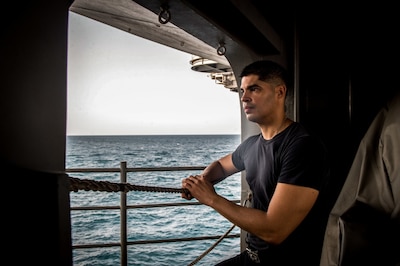By Navy Petty Officer 2nd Class Elesia K. Patten, Carrier
Strike Group 11
ABOARD USS NIMITZ AT SEA, Oct. 30, 2017 — For many sailors
aboard the deployed aircraft carrier USS Nimitz, Hurricane Maria hit close to
home. But for one Nimitz sailor, it literally hit home.
Last month, Navy Petty Officer 3rd Class Josue
Cordero-Fernandez, an aviation machinist's mate, was working in the jet shop
aboard the Navy's oldest active aircraft carrier in the Persian Gulf as
Hurricane Maria was gaining momentum, churning in the Atlantic Ocean and
barreling toward Puerto Rico.
After hearing that the Category 4 hurricane was projected to
hit his homeland, Cordero-Fernandez contacted his family back in Quebradillas
-- a small rural town located on the Puerto Rico's northwest shore. Confident
that the storm would miss, as many storms had done in the past, his experiences
kept him from worrying. But as the storm grew closer to Puerto Rico, he said,
his fears grew and he agonized in his rack, unable to sleep for almost a week.
"I lost contact with them the night before it actually
hit because communications started going down," he said. "The next
day when I started seeing pictures, I felt so useless in that moment because I
knew I couldn't do anything. I'm here on deployment."
Unable to Contact Family
Over the next few days, Cordero-Fernandez tried over and
over to contact his family, but he was unable to establish communication. He
kept his eyes glued to the TV and computer in his shop, taking in reports about
conditions in Puerto Rico.
"Seeing so much devastation around the island and not
be able to get ahold of them, I was just thinking the worst," he said.
"There's no way I can send money, because I don't have their bank
information, can't call them, can't do anything."
Cordero-Fernandez said one report told of an emergency
evacuation because the Lake Guajataca dam was about to collapse. Lake Guajataca
is significant to him, he explained, because it connects three major towns:
Isabela, San Sebastian, and Quebradillas.
"That was one of my biggest fears," he said.
"They had to evacuate around 70,000 people in case the dam collapsed. Even
though my family lives far away from it, if the collapse happened, I knew they
would not have water services for months."
Finding a Way to Help
Most services on the hurricane-ravaged island were down
immediately following the storm. Unable to physically go to the aid of his
family, Cordero-Fernandez said, he wanted to find a way to help. So that's what
he did. He got online and began buying essentials such as food and water for
his mother, siblings and nephew in Quebradillas.
"My first reaction, my first thought was, 'I have to
make sure they have food,'" he said. "Even though I don't know
anything about what's happening with my family, I'm just going to start buying
food and water and sending it back home."
Communications services were extremely limited, as Hurricane
Maria had destroyed Puerto Rico's energy grid, leaving nearly 3.5 million
people without power. But some phone and internet companies had service and
offered free hotspots to help people reach their loved ones.
Making Contact
After nearly a week of tormenting thoughts, desperately
checking Facebook, and frantically calling home, Cordero-Fernandez said, he got
good news from his family.
"I finally heard from them through Facebook," he
added. "It took me around five days to get ahold of them. It was the
greatest feeling ever. I felt relief knowing they were OK, that they didn't
suffer any property damage, and they were alive, which was the most important
thing."
The island began receiving first aid and support from
several organizations shortly after the storm hit, including the Federal
Emergency Management Agency and the U.S. military, including the Navy.
"I feel good that the Navy is providing the help we
need," Cordero-Fernandez said. "Within the first week, Navy vessels
were sent to my island to help out. I think that was a good thing.







No comments:
Post a Comment